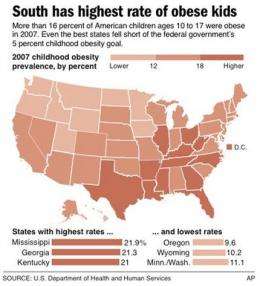Study documents geographic variation in childhood obesity: Oregon has lowest rate

The prevalence of childhood obesity and overweight appears to vary widely among states, according to a report posted online today that will appear in the July print issue of Archives of Pediatrics & Adolescent Medicine.
Over the past three decades, childhood obesity has dramatically increased in the United States, according to background information in the article. The rate of obese children has more than tripled in this timeframe and remains high among both boys and girls and across all ages and racial and ethnic groups. "In light of these trends, childhood obesity continues to be viewed as a major public health problem in the United States," the authors write.
To examine changes in obesity and overweight prevalence at the state level, Gopal K. Singh, Ph.D., and colleagues at the Health Resources and Services Administration, Rockville, Md., analyzed data from the National Survey of Children's Health Data—a larger database that permits more detailed geographic analyses than other surveys used to estimate obesity prevalence. A total of 46,707 children age 10 to 17 were surveyed in 2003 and 44,101 children participated in 2007.
Nationwide in 2007, 16.4 percent of children were obese and 31.6 percent were overweight. Prevalence varied significantly across states. Mississippi had the highest obesity rate (21.9 percent) and Oregon had the lowest (9.6 percent); Mississippi also had the highest rate of children who were overweight (44.5 percent) and Utah had the lowest (23.1 percent). The magnitude of state variations was more significant for girls than for boys.
"Between 2003 and 2007, obesity prevalence increased by 10 percent for all U.S. children and by 18 percent for female children, declined by 32 percent for children in Oregon and doubled among female children in Arizona and Kansas," the authors write. "Children in Illinois, Tennessee, Kentucky, West Virginia, Georgia and Kansas had more than twice the adjusted odds of being obese than children in Oregon."
The geographic patterns in childhood obesity are similar to those observed among adult populations, the authors note. Several Southern states—including Mississippi, Georgia, Kentucky, Louisiana and Tennessee—were in the top one-fifth of both childhood and adult obesity rates in 2007. For both adults and children, obesity rates were highest in the Southern region and lowest in the Western region.
"Individual, household and neighborhood social and built environmental characteristics accounted for 45 percent and 42 percent of the state variance in childhood obesity and overweight, respectively," the authors write. "Prevention programs for reducing disparities in childhood obesity should not only include behavioral interventions aimed at reducing children's physical inactivity levels and limiting their television viewing and recreational screen time but should also include social policy measures aimed at improving the broader social and physical environments that create obesogenic conditions that put children at risk for poor diet, physical inactivity and other sedentary activities," they conclude.
More information: Arch Pediatr Adolesc Med. 2010;164[7]. doi:10.1001/archpediatrics.2010.84













